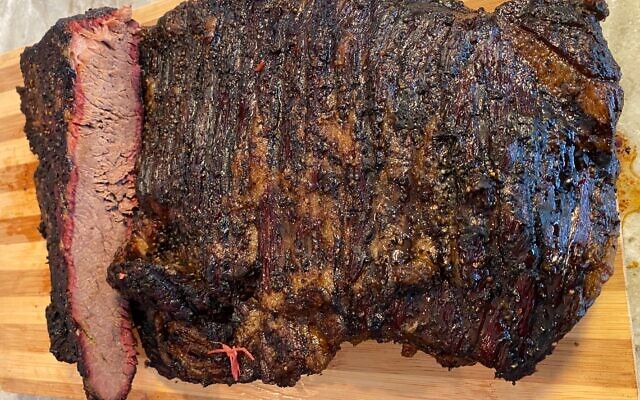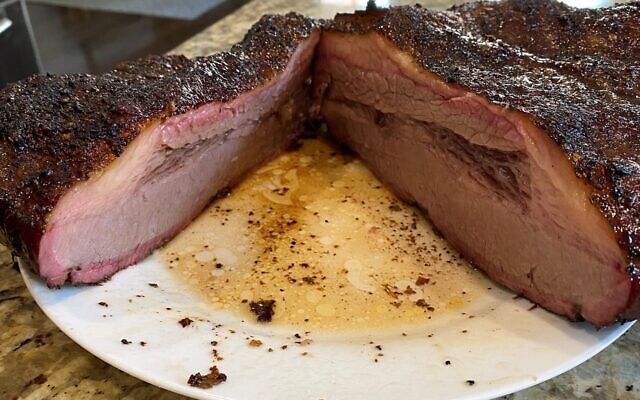Docs Boast Best Brisket
Howard Snapper and Mitchell Blass, both doctors, invest hours in seasoning, probing, grilling, and spritzing to achieve the perfect brisket reminiscent of family’s holiday table.
After 37 years with the Atlanta Journal-Constitution and now with the AJT, , Jaffe’s focus is lifestyle, art, dining, fashion, and community events with emphasis on Jewish movers and shakers.
Well-set tables for the High Holidays and Passover are known for wafting aromas and juicy slices of brisket. Then there are those meat aficionados who aptly prepare it year-round.
Ashkenazi Jews take the forefront with variations from smoking to braised pot roast, but do not own the space. Koreans, Germans, Brits, Thais, and even Italians have their own brisket versions. Texans revel about barbequing it. Perhaps the most famous culture was revealed in a 2019 Atlanta Jewish Film Festival live performance after the film presentation “Chewdaism: A Taste of Jewish Montreal.”
Kosher brisket that came from Romania to Montreal is believed to have morphed into the corned beef and pastrami touted in “Chewdaism” according to the Food Network.
Crispy, salty, crusty brisket prep can be intimidating, labor intensive and expensive, and can be even better for next day leftovers. The brisket cut comes from the lower part of the breast or chest on a cow, or calf. Preparers marvel at its ability to quiver, flop, jiggle, sag in the middle, necessitating swaddling in anything from butcher paper to a beach towel.
Locally, Dr. Mitchell Blass, infectious disease specialist, and Dr. Howard Snapper, cardiologist, lit up their social media with mouthwatering photos and instructions on this culinary art and tradition. Blass recalls, “The smell of the brisket always reminds me of being together with my family.” Snapper echoed, “My mother made brisket for all the Jewish holidays, but it was more of a roasted version.”
In an article in The New York Times last year, Steven Raichlen broke the brisket process into these components: meat, seasoning, cooker, smoke, temperature, wrap, test, rest, carve. From the Big Green Egg, blue smoke, and “the largest cut of meat most people will ever attempt to cook at home.”
Blass shares, “I look for a prime cut brisket that is usually between 10 to 12 pounds.
For ribs I ask for a rack of short ribs, uncut and still in the cryovac.
“For both, I heavily trim the fat. I use a Traeger Silverton pellet grill from Costco with hickory pellets. My brisket typically takes about six to eight hours of time on the smoker, slow and low. My rack of uncut short ribs takes longer, usually eight to 12 hours.
“Both are made very simply, salt and pepper, setting the grill at 225 degrees, and cooking until an internal temperature of 190 to 200.” Blass offers an alternative as long as the grill is fired up. He prepares fresh trout which takes 90 minutes, set at 200 degrees and cooked until flaky.

Snapper uses a Green Mountain Grill with hardwood pellets. It’s preferable to start with a whole brisket, which has two parts: one flat and the other part that’s thick and fatty, which is the most tender. “Look for a well marbled cut. Season with sea salt, black pepper, paprika and garlic powder. Set the temp at 225 to start, but stop when the internal temp hits 150. This is called ‘the stall,’ where you take it off the smoker, wrap in tin foil or butcher paper for just a few minutes, put back to smoke at 203 degrees, pull it off, wrap again, then rest it for an hour.”
Noting technology, Snapper sets the temperature to interact with his smartphone.
He checks on it hourly to spritz with apple juice and /or Worcestershire sauce to retain moisture. He cautions, “Do not cut the brisket immediately so the juices can distribute. And always cut against the grain.” His entire process takes about 12 hours.
For leftovers, Snapper said. “I wrap them tightly in plastic wrap, refrigerate, then reheat on a steamer on the stove.” Blass joked, “Reheat in a sauté pan and make for next day’s lunch. What leftovers?!”






comments